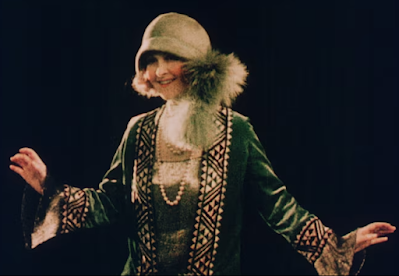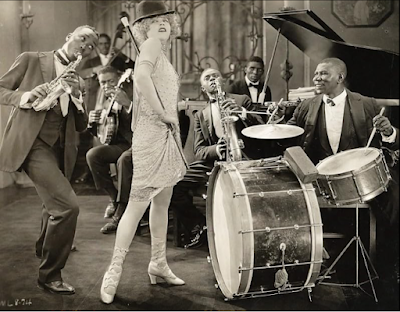And so, to penultimate day and, as the minstrel sang,
“I’m still standing…” or rather sitting, a lot, in the dark, watching. Today
there was charm Sonia Delaunay’s innovative shaping and it was approaching
midnight when Mae Murray moved to a convent, taught children, had her ankles
runover by truck and, oh my, was inspired to take up her bee-stung lips and
walk! If there was such a thing as a typical day at Le Giornate, this wouldn’t have
been it, at all.
So, let’s start at the very ending as that’s a very good
place to start as dozens of cinemutophiles (TM P. Hutchinson of Worthing) staggered
out of the Verdi trying to process what we’d just seen with Circe, the
Enchantress (1924) which progressed from a saucy mythical entree, Circe/Cecilie
Brunner (Murray) turning men into pigs (I know, right?), through nightclub
low-jinks with her gaggle of male admirers, to the aforementioned redemption
sequence. It was undoubtedly great fun and considering it was a lost film for
so long, a miracle of mythical proportions that it exists at all especially as
it shows us so much of why Mae was a true star.
While she is more than capable of inhabiting the role of
an enchantress ancient and modern, we also get a chance to see her dance as
well as pout and she can dance having, as Artemis Willis puts it in the
catalogue notes, pioneered the path from Ziegfeld Girl to Hollywood star. There’s
one number influenced by modern ballet – say Denishawn or even Isadora Duncan –
then a dance with a jazz ensemble. This is American cabaret and there’s even a
moment when Cecilie jumps into a water feature in the club and her men follow
her. There’s one gay character, not even coded and there’s William Haines too
who always has a twinkle!
Interesting that this festival has feature both Billy and
his friend Eleanor Boardman who won the "New Faces of 1922" contest
and travelled to Hollywood together. He’s good as Cecilie’s most passionately
lost paramour surrounded by harder hearts in the group all still unable to
resist their lady’s allure. It’s only when surgeon Peter Van Martyn (James
Kirkwood, Sr.) arrives on the scene that things change as he’s got the moral
strength to stand apart and Cecilie finds that very attractive.
The film has some ten minutes missing but the sense
remains even if the final turn-around is a jolt. It matters not as Murray the Enchantress
is in full bloom. Willis quotes Florence Lawrence writing in the Los Angeles
Examiner, “The story…gives the piquant star a vivid and chameleon-like
characterization. She is alternately the spoiled and petted darling of a circle
of rich adorers, and the wistful woman, beseeching attention from the one
worthwhile man in the whole of her acquaintance.”
Accompaniment was from a spirited trio comprising Günter
Buchwald (piano and violin), Aaron van Oudenallen (sax and woodwind) plus Frank
Bockius who I believe is a percussionist and without whom no GCM 42 day is
complete!
 |
| Peter C. Leska, Mady Christians and Diana Karenne |
Eine Frau Von Format (1928) proved to be the most delightful
of any of the Ruritanian stream, with a superb performance from Mady Christians
which caused my hardened heart to melt with a pitch perfect performance of wit
and intelligence, timing and a smile that charms as it disarms. Christians enjoyed
a long and successful career including as Priscilla Queen of the Deserters in The
Runaway Princess (1929) and many more. She’s got such presence and whilst
obviously not a stunner in the manner of Russian diva, Diana Karenne, she draws
the eye with expressiveness and energy.
She plays Dschilly Zileh Bey the ambassador from
Türkisien who has been sent to negotiate the acquisition of an island from Princess
Petra of Silistria (Karenne, who it was good to see again after the
rediscoveries of her work screened at this year’s Cinema Ritrovato Bologna). In
this she must compete with the ambassador from neighbouring Illyria, Count Géza
von Tököly (Peter C. Leska) and we’re into classic romcom territory from the
get-go. The Count tries to woo Princess Petra and moves her reception forward a
day so that he can be alone with the Princess, but Dschilly responds by
reversing that and leaving him to think on his feet as guests arrive in their
dozens to rain on his private parade. This is only the beginning of a
light-hearted competition that demonstrates its operatic origins as it makes
light of the diplomatic love triangle, if that’s what it is?
In their catalogue essay, Amy Sargeant and Jay Weissberg
quote a positive review from La Dépêche (02.08.1930) “It’s a lively,
graceful work, with all the colour of Viennese operetta and in a thoroughly
modern vein. It takes place in the midst of enchanting locales, on a marvellous
island that bears a strong resemblance to those of Lake Maggiore, and the
perfume of the Borromean Islands wafts ceaselessly in the luminous air.”
Meg Morley provided her own musical travelogue with
accompaniment that was as airily in touch with the film’s tone as well as
location in time and space. There were some sumptuous recurring motifs and the
playing generated the same good humour as Mady on screen, in terms of all-round
engagement a festival highlight!
 |
| Hope Hampton |
Now, you’ve either got or you haven’t got style and for
sure Sonia Delaunay’s stands out a mile. Here we had a collection of short
films showing her design as well as her influence in the case of Ballet
Mécanique (1924), that classic of cubist/Dada cinema from Fernand Léger, a
member of the Delaunay circle, along with Dudley Murphy. Then there was
striking haute couture in two-colour Kodachrome which highlighted model and actress
Hope Hampton’s shock of red hair as much as the designs from Vionnett, Poiret
et al. Hampton was in The Gold Diggers (1923), James Cruze’s Hollywood (1923), The
Truth About Women (1924) and fair few others into the talkies.
Others shorts from Germaine Dulac and Marcel Duchamp were
shown along with L’ÉLÉLÉGANCE (1926) directed by Sonia Delaunay and Robert
Delaunay and The Delaunay Keller-Dorian Colour Test (1928). All of which made
my chance meeting with some friends in Venice and our visit to the Peggy
Guggenheim Collection make artistic sense of the last eight days. Cinema was
part of the artistic innovation of the early part of the last century and there
was a boldness and dynamism which still strikes as “new” and challenging in
2023.
Masterclass student Andrea Goretti provided artful
accompaniment! Welcome on board.
Now for the quickfire round:
The slapstick special today included Modern Love (1929) which gave a rare chance to hear Charley Chase talk, the film was an
early sound film with a mix of sound and music with title cards before we get
to dialogue. Charley was in his usual mess as his dress designing wife (Kathryn
Crawford) has had to keep their relationship secret and then gets an offer of
work in Paris with a new customer, François Renault played by the super Jean
Hersholt. It’s a fine mess but you know our hero will win through and it’ll be a
lot of fun in the process. It must be said that this hybrid format was not that
popular at the time and the recording quality of the voices was not
hi-fidelity, age or original process/both.
The Oath of the Sword (1914) a story of a Japanese
family whose son goes to study in the USA and who pledges an oath with his beloved
to return on his return. Time passes, as does he with flying colours but all
this Americanisation is as nothing when he returns to find she has married a US
airman… cue the sword and that oath…
Harlem Sketches (1935) directed by Leslie Bain was a
slice of cinéma verité showing the black community of Harlem in New York City.
The title cards talked of their “miserable existence” and there is much poverty
in evidence as well as defiance and humour. The film was banned in some
American states, including Ohio, whose censorship commission turned down the
print: “Reason for Rejection: Showing Negroes of Harlem banded together in
groups carrying banners displaying Communistic ideas. Advocates equal social
rights for Negroes.”
That future the artists in Europe could see wasn’t coming
anytime soon to certain communities, was it?
 |
| Mady makes her point. |






%20look.png)







No comments:
Post a Comment